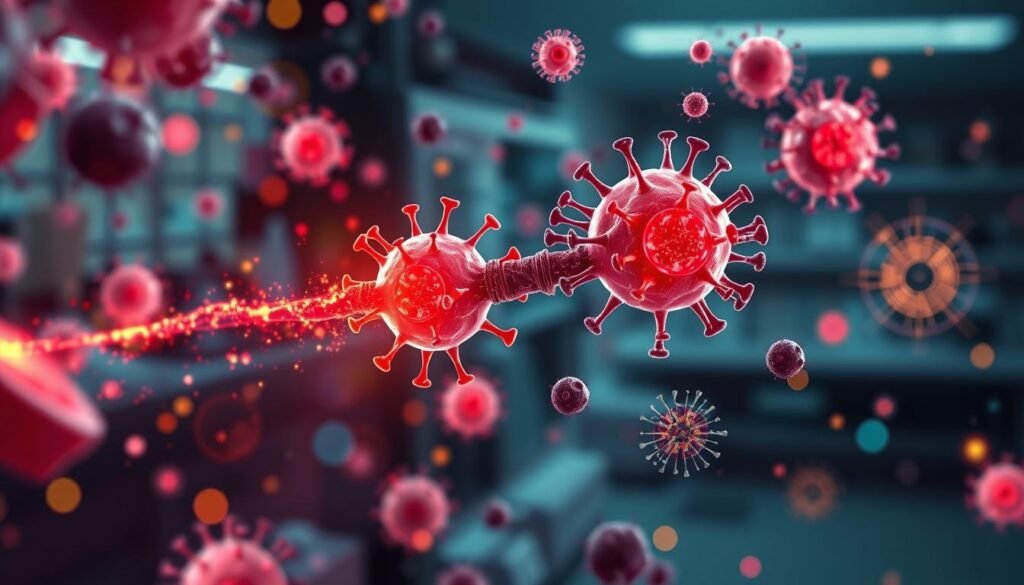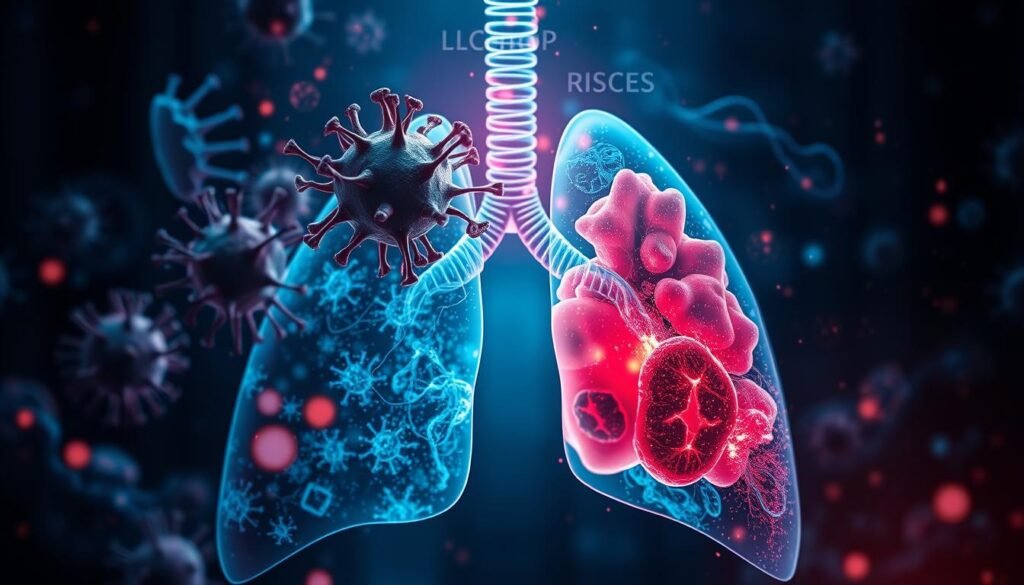In 2015, more than 733,300 new cases of non-small cell lung cancer (NSCLC) were reported in China. This led to about 610,200 deaths. These shocking numbers show the need for better lung cancer treatments. Neoadjuvant immunotherapy is a new method. It uses the body’s immune system to fight lung tumors, especially in NSCLC.
This guide focuses on cancer immunotherapy, particularly neoadjuvant therapy. We’ll look at the key ideas of immuno-oncology, how it works, and evidence that supports its use. We’ll also discuss the pros and cons of this advanced treatment.
Knowing how neoadjuvant immunotherapy for lung cancer works is crucial. Ongoing research shows it could help improve surgery results and survival rates. It might even be better than traditional methods, recent studies suggest.
For more info on treatments like radiation therapy for lung cancer, check out this resource.
Key Takeaways
- Neoadjuvant immunotherapy aims to boost the immune response against lung cancer.
- A significant number of NSCLC patients still face high rates of recurrence and mortality.
- This approach may improve both surgical and long-term outcomes for patients.
- Clinical trials are essential for understanding the efficacy of neoadjuvant therapies.
- Immunotherapy offers new hope in the battle against lung neoplasms.
Understanding Lung Cancer
Lung cancer is a big health issue and leads in cancer deaths worldwide. Around 127,000 people are estimated to die from it in the U.S. in 2023 alone. China reported 733,300 new cases of non-small cell lung cancer in 2015, leading to 610,200 deaths.
Prevalence and Statistics
Lung cancer causes over 1.7 million deaths globally, which is 18.4% of all cancer deaths. In the U.S., it’s the top cancer for men and the third for women. These numbers show how serious lung cancer is.
Types of Lung Cancer
There are mainly two types of lung cancer: NSCLC and SCLC. NSCLC makes up about 84% of cases. It includes types like adenocarcinoma and squamous cell carcinoma. Despite better treatments, 25-70% of NSCLC patients see their cancer come back after surgery.
Neoadjuvant therapy is now a key treatment for early NSCLC and could help patients live longer. The FDA recently approved a mix of nivolumab and chemotherapy. This mix offers hope for better results. For more details, see the CHECKMATE-816 trial.
What is Neoadjuvant Therapy?
Neoadjuvant therapy is a way to treat patients before their main treatment, like surgery. This method is especially used in fighting lung cancer. It aims to make outcomes better for patients. This kind of treatment lets doctors manage the disease early on.
Definition and Purpose
Neoadjuvant therapy aims to increase chances of beating the disease. It has several goals, including:
- Downstaging tumors, making them smaller and more manageable for surgical procedures.
- Increasing surgical resectability, which refers to the likelihood of successfully removing the entire tumor.
- Addressing potential micro-metastases early, thereby improving survival outcomes.
- Facilitating better patient compliance by reducing anxiety associated with surgery.
- Enabling on-treatment biological assessments through the collection of tumor specimens post-treatment.
Studies have shown that neoadjuvant chemotherapy and immunotherapy greatly improve survival rates for those with non-small cell lung cancer (NSCLC). This approach is now recognized as an effective way to boost survival rates early on. It shows that starting treatment earlier can make a big difference.
Neoadjuvant Immunotherapy Lung Cancer: A Promising Strategy
Neoadjuvant immunotherapy is changing how we treat lung cancer. This new method uses immune checkpoint inhibitors. This boosts the body’s fight against lung cancer cells. It focuses especially on early-stage non-small cell lung cancer (NSCLC). The idea is to use this therapy before surgery to make treatments work better.
Studies show neoadjuvant immunotherapy could lead to major pathology remission (MPR) rates of up to 45% in operable NSCLC. This type of treatment is given before surgery. The aim is to shrink the tumor, kill off tiny cancer spread, and cut the risk of the cancer coming back. This step matters a lot since around 85% of all lung cancers are NSCLC.
The use of immune checkpoint inhibitors is groundbreaking. Research shows these treatments not only help with surgery results. They also boost the immune system to fight cancer even after surgery. This is key to stopping the cancer from coming back. Recurrence rates for early-stage NSCLC vary. They range from 45% for stage IB to around 75% for stage III.
This new approach is showing promise in clinical trials. Evidence suggests that patients who get this therapy do better overall than those who get standard post-surgery treatment. The CheckMate 159 study looked at NSCLC patients who hadn’t been treated before and could have surgery. This study highlights how immune checkpoint inhibitors can lead to better patient outcomes and long-term remission.
Current Treatment Paradigm for Non-Small Cell Lung Cancer (NSCLC)
Non-small cell lung cancer (NSCLC) treatment uses many strategies. It depends on the cancer’s stage and traits. The main aim is to help patients live longer and better. It’s vital to know about all treatment ways as they have improved a lot.
Standard Treatment Options
For early NSCLC, surgery is key. It often comes with adjuvant chemotherapy, which helps a bit. This extra treatment can boost survival by about 5% after five years. The goal is to kill any cancer left after surgery.
Role of Surgery and Chemotherapy
Surgery is best for treating early tumors. Then, chemotherapy is used to kill any cancer that’s left. Now, doctors also use neoadjuvant chemotherapy. It can work as well as adjuvant therapy. Plus, it lets doctors see how the tumor reacts before surgery. This helps in planning better care after.
| Treatment Strategy | Advantages | Outcomes |
|---|---|---|
| Surgery for Lung Cancer | Curative intent for early-stage tumors | Standard five-year survival improvements |
| Adjuvant Chemotherapy | Reduces the risk of recurrence post-surgery | Approx. 5% increase in survival rates |
| Neoadjuvant Chemotherapy | Allows assessment of treatment response | Similar outcomes to adjuvant options |
Mechanism of Action for Immunotherapy
New treatments for lung cancer have changed the game. This change is thanks to immune checkpoint inhibitors and new understandings of the tumor surroundings. These methods boost the immune system’s fight against cancer. They bring new hope to patients.
Immune Checkpoint Inhibitors
Drugs like PD-1/PD-L1 blockers are key in fighting cancer. They help the immune system better attack tumor cells. By stopping the normal blocking of T cell activation, these drugs allow a stronger fight against cancer.
Major studies, such as CheckMate 057 and CheckMate 017, showed better survival rates with nivolumab. This marks a big change in treating non-small cell lung cancer (NSCLC).
The Tumor Microenvironment
The environment around a tumor plays a big role in treatment success. It includes immune and stromal cells, plus extracellular matrix parts. Knowing about the immune cells linked to the tumor helps make treatments with immune checkpoint inhibitors better.
Recent research shows that using different therapies together can get better results. They change the tumor environment to help T cells respond more strongly. For more information on these discoveries, read this review.
Clinical Evidence Supporting Neoadjuvant Immunotherapy
Recent advances in clinical trials have shown how powerful immunotherapy is for treating lung cancer. These studies have highlighted the benefits of using immunotherapy before surgery. They show it can lead to better responses and longer survival for people with early-stage non-small cell lung cancer (NSCLC).
Recent Clinical Trials and Results
In recent studies, neoadjuvant immunotherapy has shown to be effective. For example, in the KEYNOTE-671 study, using pembrolizumab with chemotherapy increased the survival rate to 62.4% after 24 months. This was much better than the 40.6% survival rate in patients who only received chemotherapy.
Another trial, NADIM II, showed an 85% survival rate at 24 months. This was for patients treated with nivolumab and chemotherapy, compared to 63.6% for chemotherapy alone. These outcomes support including neoadjuvant immunotherapy in treatment plans.
Phase II and Phase III Trials Overview
Phase II and III trials are critical for proving that neoadjuvant immunotherapy works. For instance, the CheckMate 159 trial looked at 21 patients with early-stage NSCLC. The results were encouraging regarding the rates of major pathological response.
It’s been consistently seen that adding immunotherapy to chemotherapy before surgery improves results. This is clearer than using chemotherapy by itself. More trials have investigated different ways to use these treatments together, showing various outcomes.
| Trial Name | Combination Therapy | 24-Month Event-Free Survival | Overall Survival |
|---|---|---|---|
| KEYNOTE-671 | Pembrolizumab + Platinum | 62.4% | N/A |
| NADIM II | Nivolumab + Platinum | N/A | 85% |
| CheckMate 159 | Nivolumab Alone | N/A | N/A |

Benefits of Neoadjuvant Immunotherapy
Neoadjuvant immunotherapy represents a big step forward in treating lung cancer that can be removed by surgery. It not only makes surgery more successful but also boosts the body’s own fight against cancer. This boost comes through better immune responses.
Improved Surgical Outcomes
Studies have shown that this therapy leads to better surgery results for lung cancer. It makes it more likely for all the cancer to be removed completely, which is key for living longer.
For instance, patients who respond well to this therapy before surgery have a better chance of not having their cancer come back. Also, combining immunotherapy with chemotherapy has reached high success rates, up to 86%. This is a sign of hope for effective treatments.
Potential for Enhanced Immune Response
Starting immunotherapy before surgery can lead to major benefits for the immune system. This early start helps fight off tiny traces of cancer, improving chances of long-term survival. It creates a stronger immune environment, helping patients better resist the cancer coming back.
Challenges and Risks Associated with Neoadjuvant Immunotherapy
Neoadjuvant immunotherapy is a new hope for lung cancer treatment. But, it comes with challenges. Two main issues are adverse events and timing of surgery. Knowing these risks helps in planning treatment and improving outcomes.
Adverse Effects
This type of treatment has improved survival rates. However, it can cause complications related to the immune system. These side effects may lead to changes in treatment. Clinical studies show we must watch these side effects closely. They can greatly affect how effective the treatment is.
Timing of Surgery
Deciding when to have surgery is crucial when using this therapy. Problems from treatment can delay surgery. This can increase the chance of the cancer getting worse. Surgeons need to carefully check how well the treatment is working. They must also consider the patient’s health to decide on the right time for surgery.

Patient Selection Criteria for Neoadjuvant Immunotherapy
Finding the right people for neoadjuvant immunotherapy in lung cancer is key. Doctors look at many factors. These include biodynamic markers and the patient’s overall health. These factors are crucial in creating an effective treatment plan.
Biodynamic Markers
Biodynamic markers are very important in picking patients for immunotherapy. For example, how much PD-L1 a patient has is a big deal. If a patient has a lot of this marker, they’re more likely to do well with immunotherapy. Doctors must check these markers carefully before starting treatment. Plus, research is always happening to find more markers that can help.
This work, along with knowing a patient’s health, helps doctors get better results.
Understanding Patient Health Conditions
The health of someone with lung cancer is a big part of deciding if immunotherapy before surgery is right. Looking closely at a patient’s health, their other health issues, and past treatments is vital. This helps doctors come up with the best plan. Studies have shown that patients who haven’t had bad side effects from previous treatments often do better with immunotherapy.
With so many things to think about, talking it over in a team of different doctors is very helpful. For more details, you can check out these studies. They show how these factors can really make a difference in lung cancer care.
| Biodynamic Marker | Significance in Patient Selection |
|---|---|
| PD-L1 Expression | Higher levels often indicate better response rates to immunotherapy |
| Other Emerging Markers | Research ongoing to validate additional markers that can predict outcomes |
Future Directions in Neoadjuvant Immunotherapy for Lung Cancer
The future of immunotherapy in lung cancer looks promising. Research is bringing new treatment strategies. These aim to better patient outcomes and lower recurrence rates.
One focus area is using dual checkpoint blockade therapies. This approach targets multiple immune checkpoints to fight tumors more effectively. Another exciting field is therapy personalization based on tumor genetics. With genetic profiling, treatments can be customized, improving the chances of success with neoadjuvant immunotherapy.

Circulating tumor markers are emerging as a way to monitor how well treatments work. This lets doctors predict outcomes more accurately and make smarter choices in lung cancer care. Studies into the main pathological remission rates of neoadjuvant immunotherapy are showing major breakthroughs could be coming.
Clinical trials are getting bigger, working to improve neoadjuvant therapy protocols. These developments might change how we treat lung cancer, helping patients live longer and better lives.
| Evolving Treatment Strategies | Potential Impact |
|---|---|
| Dual Checkpoint Blockade | Enhanced immune activation against tumors |
| Personalized Therapy | Increased treatment efficacy through tailored approaches |
| Circulating Tumor Markers | Improved prediction of treatment responses |
| Advanced Clinical Trials | Refined protocols leading to better patient outcomes |
Conclusion
The way we treat lung cancer is changing, and adding neoadjuvant immunotherapy is a big step forward. This new method is making surgery outcomes better and boosting how well immunotherapy works. In fact, 52% of patients saw a major drop in cancer signs, and 24% showed no signs of cancer after treatment.
Looking at recent studies, they show a big plus for patients getting chemoimmunotherapy before surgery over just chemotherapy. It’s specially good to see that 20% of patients had no cancer in the targeted areas and lymph nodes. Plus, 84% had their disease not get worse or even shrink, shown by scans.
The risk of dying within 30 days after treatment is very low, at 0.6%. But, we need to keep researching to tackle the hurdles of this treatment method. Immunotherapy before surgery is lighting a new path in lung cancer care. It’s giving doctors and patients alike new hope for more effective and tailored treatments.